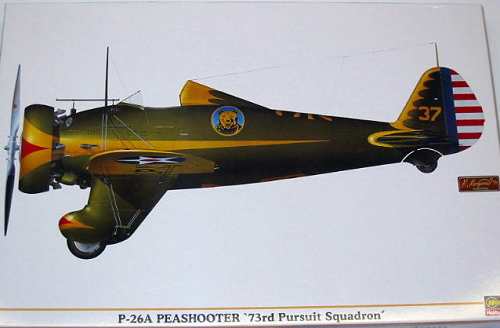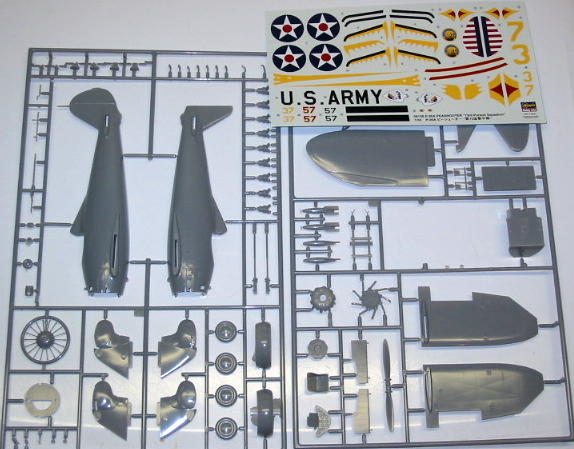
|
KIT: |
Hasegawa 1/32 P-26 A |
|
KIT # |
08128 |
|
PRICE: |
$20.00 |
|
DECALS: |
Two options |
|
REVIEWER: |
Bill Michaels |
|
NOTES: |

|
HISTORY |
The P-26 was a milestone in fighter development for the US Army Air Corps, when the prototype debuted in 1932. The plane was the first production all metal monoplane fighter to enter USAAC Service, replacing various biplane fighters. While advanced for its time, the aircraft still had the traditional open cockpit and fixed landing gear. It was also the last fighter produced by Boeing for the Air Corps— after the Peashooter, Boeing’s warplanes would be the bombers for which it became famous.
The P-26 carried the standard fighter armament of the day—two machine guns. Some aircraft carried two .30 cal guns, while others had one .30 and one .50 cal gun. The aircraft could also carry two 100 lb bombs, or five 30 pounders.
The P-26A entered mass production in December 1933, with 111 P-26A models delivered to the Air Corps by June of 1934. The early P-26A models had the low streamlined headrest of the prototype, but an early fatal landing accident resulted when a plane flipped over. As a result, the headrest was raised and strengthened to serve as a rollover pylon. Production was delayed to incorporate this change. (The only picture I’ve seen of a production P-26 with the small headrest is a picture of the first aircraft off the production line.)
The P-26 was an immediate success, outperforming the biplanes fighters of the day. An order for 25 additional P-26s followed in 1935. The first two planes of the order were built as P-26B models. The “B” model used a fuel-injected engine with a number of other changes to the fuel system. The remaining 23 aircraft in the order were P-26C models. The P-26C had minor changes from the P-26A, and externally the two models were identical.
After a trial period, the new fuel system of the P-26B was accepted, and incorporated in the remaining P-26C models then in production. These aircraft did not get a new designation- they were P-26Cs with a P-26B standard fuel system. (Some references refer to the planes from this order as B/C models.)
While the P-26 was a success, experience with the plane led to some ideas for improving the design. The Army was not keen on the aircraft’s relatively high landing speed of 82 mph, so flaps were fitted by the Army to a P-26A. These were successful, dropping landing speed to 73 mph. As a result, the flaps were added to the aircraft (A, B, or C model) on the production line, and the earlier P-26As that had already been delivered were retrofitted with flaps by Boeing.
US Army aircraft of the 1930s were brightly marked, and the P-26 was no exception. The aircraft assigned to the Pursuit squadrons carried bright, colorful markings. The basic color scheme was bright yellow flying surfaces, with either an Olive Drab or medium blue fuselage. A wide variety of stripes, scallops, and squadron logos further dressed up aircraft.
The P-26 served in front line service until replaced by the P-35 and P-36 in 1940. Some of the planes based overseas were sold to the local government, which is how the Philippines, Panama, and Guatemala Air Forces ended up with P-26As. As a result, the P-26 was still in use when WW2 broke out. P-26s of the Philippine Air Force went up against the Japanese invaders, and scored a few successes before being overwhelmed. There were even a few P-26s in Army service in Hawaii when Pearl Harbor was attacked. (I think Hobbycraft released a 1/48 scale P-26 in Pearl Harbor markings.)
|
THE KIT |

This kit has been released at least a couple of times, in different markings. My version of the kit was boxed as “17th Pursuit Group”. The kit claims to be a P-26A, but it is really a retrofitted P-26A, P-26B, or P-26C model. As such, it can be used to model just about every P-26 used in squadron service, except for the unmodified early “A” models. (Which limits you to about 99% of the possible P-26 subjects!)
The kit includes the raised headrest and flaps that were retrofitted to all the P-26A aircraft. As a result, it can be built as just about any P-26A you may fancy, as well as every B or C model. In fact, one of the decal options included in the kit is for a P-26C.
The kit consists of 64 parts, crisply molded in light grey plastic. Surface detail consists of fine recessed panel lines. Overall, the moldings look very good, with few mold lines and no flash.
The big radial engine is a prominent feature of the P-26, and the kit does a good job of replicating it. The engine is made up from about 20 pieces, with separate cylinders, and exhaust pipes.
The cockpit is reasonably detailed, with a floor, seat, stick, rudder pedals, guns, and instrument panel. There is nice sidewall detail on the insides of the fuselage. The basics look nice, but there is definitely potential for some additional detailing. The cockpit access side panel is molded as part of the fuselage, in the closed position. (It could be cut free and re-positioned without too much difficulty.)
The color information in the instructions for the cockpit is incorrect. The P-26 cockpit interior was painted an aluminum color, not neutral gray. The instrument panel was black, and not gray.
Another prominent feature of the P-26 was the external bracing wires. The kit does an OK, but not great, job here. On the plus side, the installation of the rigging is integrated into the model’s construction. For example, rigging is anchored inside the wings when they are assembled. Also, the rigging diagrams are accurate, compared to my references.
The rigging of the kit does fall a little short in a couple of areas, though. The kit does not include rigging material, nor do the instructions suggest what to use. Also, several of the wires should have stabilizing or anti-vibration bars, which are not included in the kit.
When I first looked at the model in the box, I looked at the instructions, which show four finishing options. (Three colorful US Army aircraft and a Phillipine aircraft from December, 1941.) However, when I went to build the model later, I realized that this a “special” markings edition of the kit. As a result, you do NOT get the four sets of markings shown in the instructions. Instead, you get a choice of two markings, both of which are documented on a separate insert sheet of paper in the bottom of the box.
When it comes to decaling, this kit is not for the faint of heart. In addition to all the usual markings, there are decals for the scallops on the leading edges of the headrest, stabs and fin, and the stripes on the fuselage and wheel pants. Getting the decals on the top and bottom of the stab leading edge to line up without a gap may be real challenge! (The decal-application-challenged may want to look for the “standard” version of the kit and just go with the Philippine model.)
As mentioned above, this version of the kit only gives you two choices for markings:
(1) The boxtop aircraft, from the 17th Pursuit Group, 73rd Pursuit Squadron. This aircraft has an olive drab fuselage, with yellow wings and stabs. This one will be a challenge to decal!
(2) An aircraft from the 1st Pursuit Group, 94th Pursuit Squadron. This aircraft, has the blue fuselage with yellow wings and stabs. While still colorful, it has a little simpler scheme, with a lot fewer decals. The scheme is very similar to this one – but with a different squadron badge on the fuselage stripe.
|
CONCLUSIONS |
Recommended. This looks like a good rendition of the P-26. The Peashooter was a small aircraft, so even in 1/32 scale, it still isn’t very big—with a wingspan of only xx inches. The biggest challenge of this kit may well be the decals- all those stripes and scallops could be a challenge.
If you would like your product reviewed fairly and quickly by a site that has over 250,000 visitors a month, please contact me or see other details in the Note to Contributors.